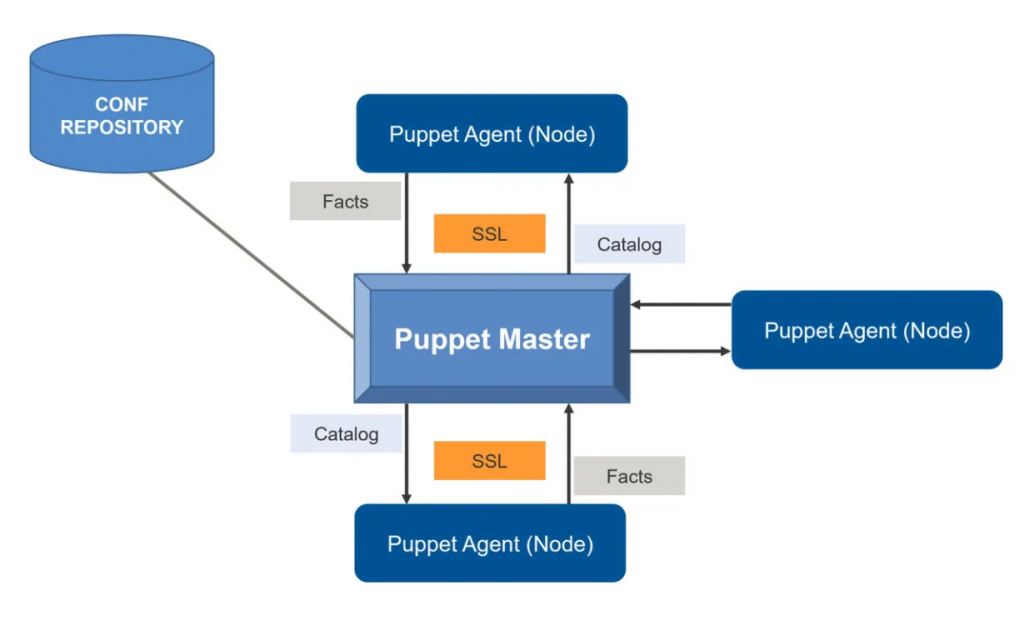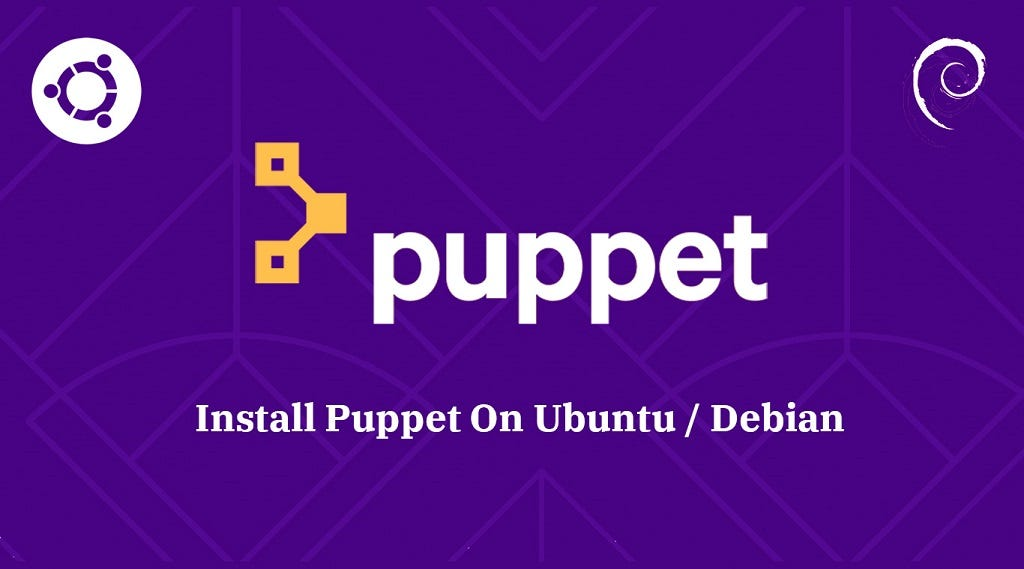What is Puppet?

Puppet is an open-source configuration management and automation tool that helps IT operations teams automate the provisioning, configuration, and management of infrastructure and applications. Puppet uses a declarative language to define desired system states, and it ensures that systems are consistently configured and compliant with desired configurations.
These use cases reflect Puppet’s versatility in managing and automating various aspects of IT operations and infrastructure. Puppet is widely used across industries to streamline IT management, improve efficiency, reduce errors, and enhance security and compliance.
Top 10 use cases of Puppet:
Here are the top 10 use cases of Puppet:
- Configuration Management: Puppet’s primary use case is configuration management. It allows organizations to define the desired configuration of systems and ensures that they remain in that state, even as changes are made over time.
- Infrastructure as Code (IaC): Puppet can be used to implement infrastructure as code practices, where infrastructure configurations are defined and managed in code, enabling automated, repeatable deployments.
- Automated Provisioning: Puppet can automate the provisioning of new servers and instances, ensuring that they are configured correctly from the start.
- Application Deployment: Puppet is often used for deploying and managing applications. It can ensure that application components, dependencies, and configurations are consistent across all instances.
- Patch Management: Puppet can be used to automate patch management processes, ensuring that systems are up to date with the latest security patches and updates.
- Compliance and Security: Puppet helps organizations enforce security and compliance policies by ensuring that systems adhere to predefined security configurations and standards.
- Change Control: Puppet provides change management capabilities, allowing organizations to track and document changes to system configurations, making it easier to troubleshoot issues and roll back changes if necessary.
- Scaling Infrastructure: Puppet helps organizations scale their infrastructure up or down automatically in response to changes in demand or traffic.
- Multi-Cloud and Hybrid Cloud Management: Puppet can manage infrastructure and applications across multiple cloud providers and on-premises data centers, providing consistency and flexibility in hybrid and multi-cloud environments.
- Configuration Drift Remediation: Puppet continually monitors and enforces the desired configuration, automatically remediating any configuration drift that occurs due to manual changes or unintended alterations.
What are the feature of Puppet?
Puppet is a powerful configuration management and automation tool that offers a range of features and capabilities for managing and orchestrating IT infrastructure. Here are the key features of Puppet:
- Declarative Language: Puppet uses a declarative language to define the desired state of systems, allowing administrators to specify what the configurations should look like rather than writing step-by-step instructions for how to achieve that state.
- Idempotence: Puppet is idempotent, which means that applying the same configuration multiple times will result in the same state, making it safe to run configurations repeatedly.
- Resource Abstraction: Puppet abstracts system resources (e.g., files, packages, services) into resource types, simplifying configuration management and making it more platform-agnostic.
- Dependency Management: Puppet automatically manages dependencies between resources, ensuring that configurations are applied in the correct order to meet desired state requirements.
- Modularity: Puppet allows administrators to organize configurations into reusable modules, making it easier to manage configurations and share them within the organization or the Puppet community.
- Reporting and Logging: Puppet provides reporting and logging capabilities to track changes, view configuration history, and troubleshoot issues.
- Extensibility: Puppet can be extended through custom facts (system information), functions, and types to accommodate unique use cases and integrate with external systems.
- Agent-Driven: Puppet operates using an agent-master model, where Puppet agents run on target systems and communicate with a central Puppet master server. This enables centralized configuration management.
- Auditing and Compliance: Puppet can be used for auditing and compliance purposes, ensuring that systems adhere to security policies and regulatory requirements.
- Change Control and Rollback: Puppet enables organizations to implement change control processes by tracking changes and providing the ability to roll back configurations to previous states.
- Integration: Puppet integrates with various external tools and services, such as version control systems (e.g., Git), cloud providers (e.g., AWS, Azure), and orchestration tools.
How Puppet works and Architecture?

Puppet’s architecture and how it works can be summarized as follows:
- Puppet Master: The Puppet master server is the central component that stores configuration data and manifests (Puppet code). It compiles configurations and serves them to Puppet agents.
- Puppet Agent: Puppet agents run on target systems and communicate with the Puppet master. They apply configurations based on the manifests provided by the master.
- Catalog Compilation: When a Puppet agent contacts the Puppet master, the master compiles a catalog (a set of resource declarations) specific to that agent based on the desired state defined in manifests.
- Catalog Application: The Puppet agent applies the catalog by managing system resources (e.g., installing packages, configuring files, starting services) to achieve the desired state.
- Reporting: Puppet agents report their activity back to the Puppet master, allowing administrators to track changes and monitor system configurations.
- External Data Sources: Puppet can retrieve external data, such as system facts or data from external sources, to inform configuration decisions.
Overall, Puppet provides a structured and automated way to manage and maintain the desired state of IT infrastructure. It helps organizations achieve consistency, reduce manual configuration efforts, and improve the efficiency and reliability of their systems. Puppet’s declarative language and modular approach make it a valuable tool for configuration management and automation in diverse IT environments.
How to Install Puppet?
To install Puppet, you can use the following steps:
- Download the Puppet package. You can download the Puppet package from the Puppet website.
- Install the Puppet package. The specific steps involved in installing the Puppet package will vary depending on your operating system. Here are some general instructions:
- Linux: Use a package manager such as
aptoryumto install the Puppet package. - macOS: Use a package manager such as
homebrewormacportsto install the Puppet package. - Windows: Use the Puppet installer to install the Puppet package.
- Linux: Use a package manager such as
- Configure Puppet. Once the Puppet package is installed, you need to configure Puppet. This includes configuring the Puppet master and agent nodes.
For more detailed instructions on how to install and configure Puppet, please refer to the Puppet documentation.
Some additional tips for installing Puppet:
- Make sure that your system meets the minimum requirements for Puppet. You can find the minimum requirements on the Puppet website.
- If you are installing Puppet on a production system, be sure to test Puppet thoroughly before deploying it.
- If you have any questions or problems installing Puppet, please contact Puppet Support for assistance.
Example of how to install Puppet on Ubuntu 22.04:
- Update the package list:
sudo apt update- Install the Puppet package:
sudo apt install puppet-agent- Verify that the Puppet agent is installed:
puppet agent --versionThis should output the version of Puppet that is installed.
- Configure the Puppet agent. You can do this by editing the
/etc/puppetlabs/puppet/puppet.conffile. - Start the Puppet agent:
sudo systemctl start puppet-agentThe Puppet agent will now start running and will start reporting to the Puppet master.
Once Puppet is installed and configured, you can start using it to manage your infrastructure.
Basic Tutorials of Puppet: Getting Started

The following steps are the basic tutorials of Puppet:
Creating a new Puppet manifest
- Create a new file with a
.ppextension. This is the Puppet manifest file. - Add the following code to the manifest file:
Puppet
node 'localhost' {
file { '/tmp/hello.txt':
ensure => file,
content => 'Hello, world!',
}
}
This manifest will create a new file called /tmp/hello.txt with the content “Hello, world!”.
Applying the Puppet manifest
To apply the Puppet manifest, you can use the following command:
puppet agent --test
This command will run the Puppet agent in test mode, which will show you what changes would be made but will not actually make any changes.
To actually make the changes, you can use the following command:
puppet agent
This command will run the Puppet agent in normal mode, which will make the changes specified in the manifest file.
Verifying the changes
To verify that the changes were made, you can check the /tmp/hello.txt file. The file should contain the content “Hello, world!”.
Writing more complex Puppet manifests
Puppet manifests can be as simple or as complex as you need them to be. You can use Puppet to manage all aspects of your infrastructure, including servers, networks, and applications.
To write more complex Puppet manifests, you can use the following resources:
- Classes: Classes are used to organize and reuse Puppet code.
- Parameters: Parameters are used to pass values to classes and other resources.
- Facts: Facts are used to collect information about the nodes that Puppet is managing.
For more information on writing Puppet manifests, please refer to the Puppet documentation.
Example of a more complex Puppet manifest:
Puppet
class my_class {
parameter my_param {
default_value => 'default_value',
}
file { '/tmp/my_file.txt':
ensure => file,
content => "My content: $my_param",
}
}
node 'localhost' {
include my_class {
my_param => 'my_new_value',
}
}
This manifest will create a new file called /tmp/my_file.txt with the content “My content: my_new_value”.
Using Puppet to manage multiple nodes
Puppet can be used to manage multiple nodes by configuring the Puppet master and agent nodes.
The Puppet master is responsible for storing the Puppet manifests and distributing them to the agent nodes. The agent nodes are responsible for running the Puppet manifests and making the changes specified in the manifests.
Puppet is a powerful tool that can be used to manage your infrastructure. By following these basic tutorials, you can learn how to start using Puppet to manage your servers, networks, and applications.
Email- contact@devopsschool.com

 Starting: 1st of Every Month
Starting: 1st of Every Month  +91 8409492687
+91 8409492687  Contact@DevOpsSchool.com
Contact@DevOpsSchool.com
